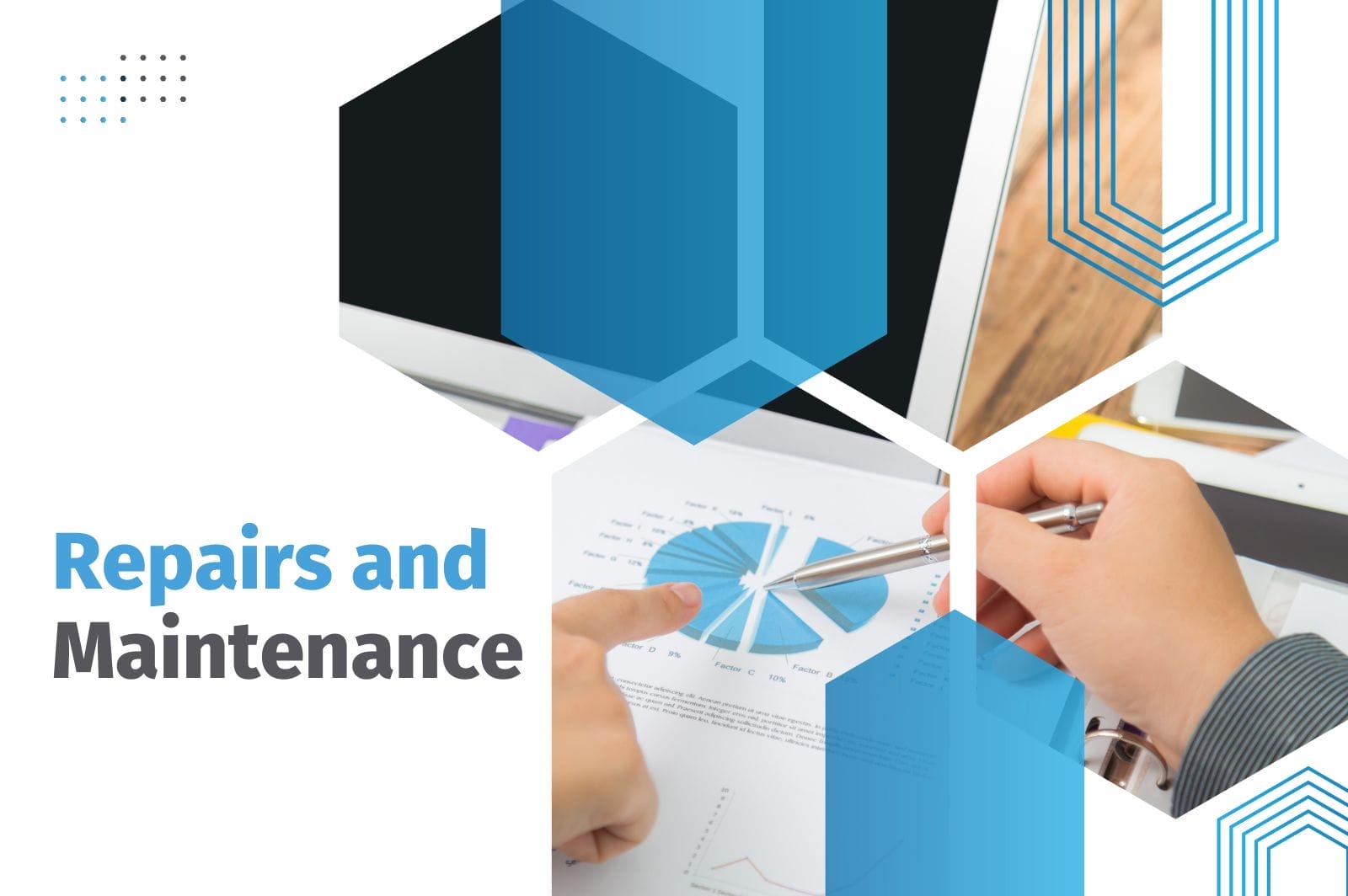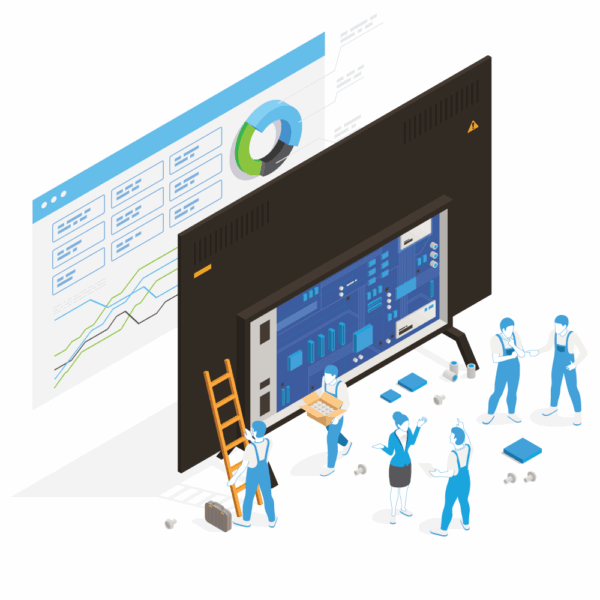
Repairs and maintenance are important for any business, ensuring the longevity and efficiency of equipment and facilities. Regular maintenance minimises downtime, prevents costly disruptions, and extends the lifespan of assets. Let’s explore the importance of repairs and maintenance, explain how to calculate these costs accurately, and discuss the significance of comparing your expenses with industry benchmarks. Additionally, we will provide strategies to improve your maintenance practices, helping you optimise performance and reduce costs. By understanding and implementing these practices, businesses can ensure sustained success and operational excellence.
Jump ahead to read:
Why is Repairs and Maintenance Important?

Understanding the importance of repairs and maintenance is important for sustaining business operations.
➤ Operational Efficiency
Regular repairs and maintenance ensure that machinery and infrastructure function smoothly, minimising downtime and preventing costly disruptions. Efficient operations are the backbone of any successful business. When equipment is well-maintained, it performs reliably, allowing business activities to proceed without interruptions. This continuity is especially important for small businesses, where even brief downtime can significantly impact productivity and profitability. By prioritising regular maintenance, businesses can avoid unexpected breakdowns and the resultant loss of revenue.
➤ Financial Prudence
Investing in maintenance can save significant amounts in the long run by avoiding major repairs or replacements. A proactive approach to maintenance allows businesses to address minor issues before they escalate into costly problems. Regular upkeep and timely repairs help manage expenses more predictably, facilitating better budget management. This financial prudence ensures that resources are used efficiently, reducing the likelihood of large, unexpected expenditures that can strain finances. Moreover, well-maintained equipment often operates more efficiently, leading to cost savings in energy and operational costs.
➤ Long-term Benefits
Consistent maintenance enhances the lifespan of equipment and facilities, ensuring they serve the business well beyond their expected life cycle. This approach supports sustainability by reducing waste and the need for frequent capital expenditures. Prolonging the useful life of assets means that businesses can defer the high costs associated with purchasing new equipment. Additionally, a commitment to regular maintenance reflects a company’s dedication to quality and reliability, which can positively influence customer perceptions and strengthen market reputation. Overall, investing in maintenance is a strategic decision that supports long-term business stability and growth.
How to Calculate Repairs and Maintenance?

Calculating repairs and maintenance costs accurately is important for effective financial planning and management.
Formula:

Explanation:
- Labour Costs: This includes the wages of in-house maintenance staff and any fees paid to external service providers. Regular maintenance tasks often require skilled labour, and accurately accounting for these costs ensures that businesses budget effectively for these important services.
- Material Costs: This covers the expenses for spare parts, tools, and other materials needed for maintenance activities. Regularly tracking and summing up these expenses helps in understanding the ongoing costs associated with keeping equipment and facilities in good working order.
- Overhead Costs: These are indirect costs related to maintenance activities, such as transportation, utility expenses, and administrative support. Overhead costs can be more challenging to track, but they are important for gaining a complete picture of maintenance expenses. Including these costs in the calculation helps businesses understand the full financial impact of their maintenance programs.
When calculating repairs and maintenance costs, businesses should also consider tax implications and industry-specific factors that may influence these expenses. For example, certain maintenance activities might be tax-deductible, providing financial benefits. Additionally, industry standards can vary, and understanding these nuances can help businesses align their maintenance budgets with best practices in their field. Properly accounting for all these elements ensures that financial planning is comprehensive and supports the long-term sustainability of the business.
Why Compare Repairs and Maintenance to Industry Benchmarks?

Comparing repairs and maintenance costs to industry benchmarks provides valuable insights for business improvement.
➤ Performance Evaluation
Benchmarking helps businesses understand their performance relative to competitors, identifying areas where they excel or lag. By comparing repairs and maintenance costs with industry standards, businesses can evaluate their operational efficiency. This comparison highlights strengths and weaknesses, enabling companies to pinpoint specific areas needing improvement. For instance, if a business finds its maintenance costs are higher than the industry average, it can investigate further to uncover inefficiencies or over-expenditures.
➤ Cost Management
By comparing costs, businesses can identify inefficiencies and opportunities for cost savings, ensuring they allocate resources effectively. Benchmarking provides a clear picture of where money is being spent and how it measures up against industry norms. This insight is important for managing budgets and identifying areas where costs can be reduced without compromising quality. For example, if a company’s labour costs are significantly higher than the benchmark, it might consider training programs to improve productivity or negotiating better rates with service providers.
➤ Best Practices
Benchmarking can reveal industry best practices, guiding businesses in adopting more effective maintenance strategies. Learning from peers and industry leaders helps businesses stay current with the latest maintenance techniques and technologies. Adopting proven practices can lead to more efficient operations and better use of resources. For instance, if benchmarking shows that predictive maintenance is a common practice among top performers, a business might implement this strategy to improve its own maintenance outcomes.
➤ Competitive Advantage
Staying aligned with or ahead of industry standards ensures businesses remain competitive, enhancing their market position. Regularly comparing maintenance practices and costs with industry benchmarks helps businesses stay competitive. It ensures they are not lagging behind and helps identify innovative practices that can provide a market edge. A business that continually improves its maintenance efficiency can offer more reliable services or products, which can attract and retain customers.
➤ Risk Mitigation
Understanding where a business stands helps in foreseeing potential risks and preparing accordingly, reducing unexpected downtimes or failures. Benchmarking provides a framework for risk assessment by identifying gaps and vulnerabilities in maintenance practices. By understanding these risks, businesses can develop strategies to mitigate them, such as implementing regular inspections or investing in more robust maintenance technologies. This proactive approach can prevent unexpected breakdowns, reducing downtime and associated costs.
Comparing repairs and maintenance costs to industry benchmarks is a strategic tool for businesses. It aids in performance evaluation, cost management, adoption of best practices, competitive positioning, and risk mitigation, ultimately leading to more efficient and effective maintenance operations.
Strategies to Improve Repairs and Maintenance Results

Implementing effective strategies can significantly enhance repairs and maintenance outcomes.
➤ Regular Inspections
Conducting regular inspections helps in early identification of potential issues, allowing for timely interventions. Routine checks ensure that any wear and tear or minor faults are detected before they escalate into major problems. By scheduling frequent inspections, businesses can maintain a proactive approach to maintenance, minimising unexpected breakdowns and extending the lifespan of their equipment. This strategy not only ensures operational efficiency but also saves costs by preventing extensive repairs or replacements.
➤ Predictive Maintenance
Utilising predictive maintenance technologies can anticipate failures before they occur, improving reliability and efficiency. This approach leverages data analytics and machine learning to predict when equipment might fail, allowing for preemptive repairs. Predictive maintenance can significantly reduce downtime and extend equipment life by addressing issues at the optimal time. Investing in such technologies can initially be costly, but the long-term benefits in terms of reliability and cost savings often outweigh the initial expenditure.
➤ Training Staff
Ensuring maintenance staff are well-trained and up-to-date with the latest techniques and technologies boosts the quality and effectiveness of maintenance work. Ongoing training programs can enhance the skills of the maintenance team, enabling them to perform their tasks more efficiently and accurately. Well-trained staff are better equipped to handle complex maintenance issues, implement new technologies, and adhere to best practices. This investment in human capital is important for maintaining high maintenance standards and achieving better results.
➤ Maintenance Scheduling
Developing a structured maintenance schedule helps in systematic upkeep, reducing the likelihood of unexpected breakdowns. A well-planned schedule ensures that all equipment receives regular attention, based on its specific maintenance needs and usage patterns. Scheduling also helps in allocating resources effectively, ensuring that maintenance activities are evenly distributed and do not overwhelm the maintenance team. This structured approach helps maintain consistency in maintenance efforts, leading to improved equipment performance and longevity.
➤ Leveraging Technology
Using maintenance management software can streamline processes, track maintenance activities, and provide valuable data for decision-making. These tools can automate routine tasks, such as scheduling and inventory management, reducing the administrative burden on the maintenance team. They also offer real-time insights into maintenance operations, helping managers make informed decisions. By leveraging technology, businesses can enhance the efficiency and effectiveness of their maintenance processes, leading to better overall outcomes.
Adopting these strategies—regular inspections, predictive maintenance, staff training, structured scheduling, and leveraging technology—can significantly improve repairs and maintenance results. These approaches ensure that maintenance is proactive, efficient, and effective, supporting the long-term operational success of the business.
Regular repairs and maintenance are essential for the smooth operation and financial health of a business. By understanding their importance, accurately calculating costs, benchmarking against industry standards, and employing effective strategies, businesses can ensure sustained success and operational excellence. These practices help minimise downtime, prevent costly disruptions, extend the lifespan of equipment, and ensure efficient use of resources. Ultimately, a proactive approach to repairs and maintenance supports long-term business stability and growth, enhancing both performance and profitability.
